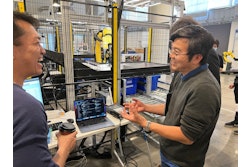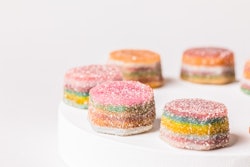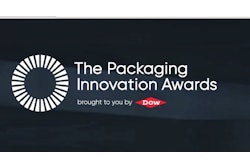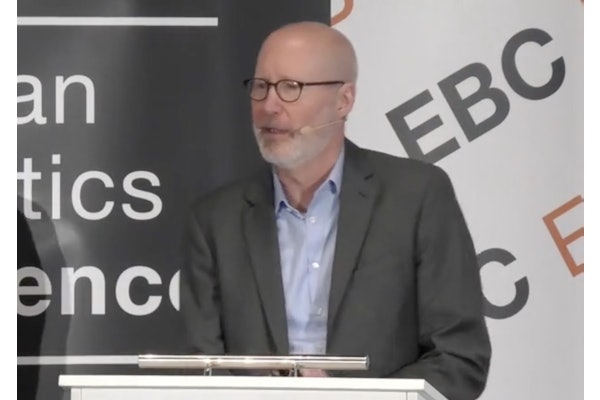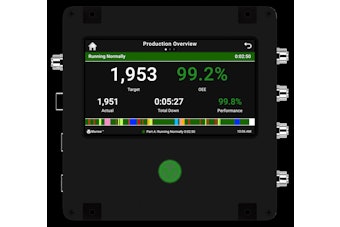Want to stay ahead in the E-Commerce market? Watch the full free video here: Designing a Sustainable E-Commerce Package in Today’s Competitive Packaging Landscape
Listen to the story here:
 | Read the transcript below: |
Matt Reynolds: Hello, welcome to today's webinar. I'm Matt Reynolds, editor of Packaging World Magazine and I'm here with Paul Jenkins, Managing Director of ThePackHub.
Paul Jenkins: Obviously, with the growth of the e-commerce channel has seen the growth of protective packaging, the increase in the the amount of packaging required to ensure that the products arrive in a safe way, undamaged, which has its own environmental challenges if products do get broken. So, the plastic bubble wrap, ubiquitous, been around for many years. It's being challenged in terms of alternative ways of delivering that service. So, Papair is a German packaging company based in the Hanover region that manufactures a paper alternative to conventional plastic bubble wrap. A Papair bubble wrap is made of 100% recycled paper and does not use any plastics or adhesives in its construction. So not only is it made a paper, it is also using a recycled material as well which ticks another box. Each paper fiber can pass through the recycling process apparently up to eight times. The high cushioning effect is created by the special geometric shape of the bubbles in combination with a two layer processing of the paper. This makes the bubble wrap particularly stable. Papair products are claimed to be cost neutral. This is quite key here compared to their plastic counterparts. And the business hopes to actually be able to undercut the price of plastic bubble wrap in the future. This is made possible by steadily rising prices of conventional manufacturers due to regulations such as the plastic packaging tax, etc. But so Papair is available as a wrapping, bags, or boxes. So that's a really good example of a plastic alternative for the ubiquitous bubble wrap.
Matt Reynolds: Yeah, but will we be able to snap these bubbles? That satisfying snap of plastic bubble wrap is maybe a thing of the past. That's, there's some sadness there.
Paul Jenkins: There is absolutely, and that is a past time which is, will be no more, but perhaps for for the good of the environment, who knows. Next up is a company, another German manufacturer. They're molded parts and packaging, and made a box of Styrofoam expanding polystyrene, called Schaumaplast. They've launched a range of thermal boxes made from natural fibers under the THERMOCON Nature name, which is a biomass balanced Styrofoam. The boxes are intended for the refrigerated shipping of both food and medicines. This new material was said to have the same quality properties and performance as conventional Styrofoam. Expanded polystyrene has been under a lot of pressure in recent times, and many businesses have looked for alternative, more recyclable, more environmentally friendly alternatives. And here is another example. The solution is made from 100% renewable raw materials and amongst other things grass, hemp, or wood fibers are used for the production. According to the company, it strictly ensures that no edible raw materials are used, so it's not taken from the food chain. And minimal amounts of binding fibers are mixed into the natural fibers, and these too are partly made from recycled materials. And quite importantly, the business makes claims around CO2 reductions. They're saying that their solution produces 75% Less CO2 compared to conventional Styrofoam. So not only does it deliver from a recyclability point of view, and in the life scenario point of view, it also delivers less CO2, which obviously, with the global warming situation that we're in, can only be a good thing. Finally, they claim that the CO2 emission reduction is equivalent to a 10,000 Kilometer, so that's about a 6000 mile car journey.
Matt Reynolds: Yeah, yeah, we're seeing this all over. You know, thermal insulation and improved thermal insulation has been catching food up with durable goods. You know, personal care electronics have been there easily shipped because there's no cold chain involved. But thermal insulation along with refrigerants can allow that to happen. Problem is it's historically viewed as as a very unsustainable way of doing things. So we're seeing new innovations and new fibers all over. I was at PACK Expo East just a few weeks ago in Philadelphia, and I stopped by the Veritiv booth and there was Kip Thompson there, showing me some of what they're showing and that's fiber based materials. So this specifically is a starch based panel system called Storopack starch insulated panels. Now Storopack and Veritiv have some sort of exclusivity agreement, where Veritiv is the distributor, but this takes square aim at the cold chain food delivery market. So I would call it meal kit, you might call it home chef or a recipe box. It's all part of, cut from the same cloth. And while these packaging systems for meal kits, you know, often use corrugated as we can see here, they're also frequently forced to use difficult to recycle materials to help maintain that cold chain. In my experience, and this was early on with the Blue Apron, pre pandemic even. That would be like a metallized laminate film that may contain plastic bubble wrap, as we just mentioned. Anything to contain that thermal insulation to make sure proteins and other, you know, sensitive temperature sensitive products arrive intact without spoilage. But for the end consumer, that often means some portion of the packaging is not going to be curbside recyclable. So this product Storopack starch insulated panels are fully compostable starch panels, and they're recyclable plastic components. Whatever plastic is in there is recyclable. And most importantly, in terms of food waste, and prevention of food waste is that this can maintain 60 to 70 hours of thermal protection at two to eight degrees Celsius. And the conversion, Paul, as I know now is 35 to 46 degrees Fahrenheit, alongside some refrigerants. So that's important to remember that refrigerants are still part of the process. So here's another recent system that we saw is from truLOCAL. truLOCAL is, it's a Canadian protein brand. So it connects local butchers to be able to deliver, and it was particularly during the time of the pandemic really important to be able to deliver quality meats, frozen meats, and sausage and protein, this sort of thing. And it converted, again, as Paul mentioned from expanded polystyrene, because consumers were clamoring against the use of that. And they found a partner in Ranpack, who is developing a waved paper pad that would replace bubble wrap or even polystyrene in this case. So they use a wrap pack protector, which is an actual piece of equipment that has roll stock fed kraft paper, and that converts into these waved paper pads. Here's another brand that's using this called Taartenwinkel. Taartenwinkel is a Dutch brand that uses the same waved paper to, with refrigerant, to be able to deliver within 30 hours, within a day that fresh baked good to, you know, for a birthday party the following day or something like that. So those are just two examples using this Ranpack wrap protector waved paper system as a replacement for EPS expanded polystyrene. But important, I keep bringing up the refrigerants because it's important that that we understand that there is another piece of the puzzle. It's not just the packaging, it's the refrigerant itself and that's long been associated with very difficult to recycle materials. But in this case, we're looking at a cool pack that's completely recyclable, according to the manufacturer. That's Recycold, clever name. And I think they've been purchased by Ranpack in the intervening years when I was initially covering these. But unlike typical cool packs, these recycled cool packs are made from a drain safe plant based gel so you can actually empty out the gel into the drain and then recycle the kraft paper based cold pack itself. Now Paul, I think you have a few other examples of something along these lines, more sustainable refrigerants or cool packs.
Paul Jenkins: Absolutely I do yeah, so this is a solution that does away with the need for cool packs or gel packs in its entirety, and uses corrugated to give the product sufficient shelf life or protection in its short supply chain journey. So this is from leading European corrugated packaging manufacturer Smurfit Kappa, very active in this space. And they've been working with UK home delivery recipe box company Mindful Chef. Now this sector has grown exponentially in the last two or three years for obvious reasons. I'm a Mindful Chef customer and I've actually experienced this specific innovation which, literally the box changed about a month ago from what they were previously doing to this solution. So Mindful Chef were looking to find a replacement for the insulation they used in their ingredient kits. The previous packaging solution saw boxes using gel ice packs, as I mentioned, which were effective at keeping the contents cool, but were not easily recycled. So the challenge was to present it to the experts at Smurfit Kappa's excellent experience center in the UK. And their solution was a two piece telescopic design made from easy to recycle corrugated board. It's been thoroughly tested various different places to ensure that it meets the strict requirements for fresh food transportation, and during testing the new packaging solution demonstrated it was able to keep ingredients under 8 degrees celcius for 30 hours in ambient conditions. So this is quite an interesting solution that uses the excellent properties of corrugated board to deliver a product that no longer needs a gel pack. So Smurfit also say that the new corrugated solution has, again a 30% lower carbon footprint than the previous installation initiative they had. Another innovation of this type. This is from the US now, Cincinnati based ProAmpac, and they've announced the launch of proactive recyclable paper mailer. Compared to a regular kraft paper mailer, their proactive recyclable paper mailer has a 70% lower water absorption, ensuring that goods arrive at their destination as intended. We're all receiving so many parcels now. And not everyone can be at home. So there is a situation where where parcels and packages are being left outside, so the ability to stay drier for longer is an important attribute. The mailers are also suitable for curbside recycling and used through standard paper recycling streams. The side seam construction gives a less industrial look than traditional center seam paper mail, which I think is important for the end consumer. And they can be manufactured with either a single closure option, or a dual closure for added security and protection. So a versatile solution here from ProAmpac. And it can also be fitted with a base gusset to allow for more space for bulkier items. So, available currently online in three stock sizes, but also having those variable alternatives that I've just mentioned. Next up is a company called Sustaination. They're an Indones.. business, Indonesian business even, that was formed in 2018 with the aim of helping the Indonesian people become more environmentally sustainable. They have introduced an alternative to plastic bubble wrap, which is, as we've already discussed, quite difficult to dispose of, or recycle. Their product is called Papelpack. And it's made from unbleached kraft paper, which has a honeycomb structure and expands to one and a half times its original size. It is recommended for any product that conventional bubble wrap is used for. Papelpack, Papelpack is just one of a range of products in Sustaination's website to help the people of Indonesia become more environmentally responsible. So they have solutions for different categories in personal care, laundry and cleaning products, as well as baby products. So another good example of an alternative to the ubiquitous and rather humble plastic bubble wrap.
Matt Reynolds: Yeah, and Paul, it strikes me we hadn't mentioned this before. But these bubble wrap replacers, it's not, the bubble wrap only function isn't necessarily impact resistance or, you know, or any kind of, you know, in the case of a metallized foil with bubble bubble wrap, that might be some thermal insulation. But often it's just, it's used as bracing or just to hold a product in place. So that previous example that you had, the fact that it's one contiguous piece of material would, you know, I can see a lot of applications for it. For instance, in distribution centers where you have a single box that might have three to four different items within it, that are, you know, stand alone or would you know, otherwise be able to move around in the box. Some of these replacers are more sustainable versions of dunnage, essentially, or bracing that hold those products in, in a certain spot as it's traveling through the supply chain. So sorry, I didn't mean to interrupt, I could just see other applications for these as we go.
Paul Jenkins: Absolutely. And a lot of these innovations. Hopefully the people watching will say actually, I can see an application here or there, and it's much broader and wider than the specific examples that we may be showing. The next up is from a UK packaging company called HexcelPack, and they've launched a fully biodegradable and curbside recyclable protective barrier made from paper under the brand name Hexcel'ope, which is the play on the words of envelope. Using the company's patented slit paper technology to expand the paper into three dimensional rigid cushion. So rather like the previous, one of the previous examples, offers a strong and sustainable alternative to plastic based bubble envelopes, which are notoriously difficult to recycle partly because consumers just aren't motivated or educated, if you like, to separate the materials and put them in different trash cans for recycling. It just doesn't happen at scale. That's the reality. So many companies are working on paper based solutions for this very reason. This answer is more suitable for e-commerce as it provides the necessary protection for the delivery and shipment of fragile products.
Matt Reynolds: Yeah, we've clearly had bubble wrap on the brain here because we've seen examples throughout our presentation but really I mean e-commerce requires some elements that will serve as dunnage. I mentioned bracing, holding products in place, and also impact resistance. And this is an interesting example of a wool based bubble wrap with, it's got really great impact resistance qualities. This is from a company called Woola, W O O L A, established in 2019. That produces packaging material from sheep's wool residues. So it's an Estonian startup that I believe has some production in Poland right now. But the whole purpose is to disrupt the e-commerce market by decreasing the production, consumption, and landfill waste of what they would consider environmentally harmful materials. Like again, I'm sorry, to vilify EPS, but expanded polystyrene really has gotten the short end of the stick when it comes to e-commerce and, and sustainability. So this product specifically is shockproof. Again, really good impact resistance qualities heat proof, and it's at home compostable at six months, so you can put it in your garden and they'll be gone soon enough. And what I think is really important from a sustainability point of view, and not necessarily center of the bullseye sustainability, but kind of on the margins on the tertiary you know, regions, it's, it's produced from an existing material that would have been wasted anyways. It's, it's a found resource, it's an abundant resource, because, you know, during the wool harvesting process, there's just a lot of waste and this would have been thrown away otherwise. So it's unique and interesting to kind of upcycle or reuse or find a found resource and that was particularly interesting with this product.
Paul Jenkins: Absolutely. Next up is protected packaging business Pregis, and they've announced the launch of their Renew Zero which is 100% recycled content, carbon neutral, air cushioning film. We're hearing a lot of more recent language around carbon neutrality, carbon negativity, etc, as the world finally wakes up to the challenges of an ever increasing carbon footprint. This 100% recycled polystyrene, polyethylene film is made from 50% post consumer recycled content and 50% from renewable sustainable plant waste, such as cellulose fibers. The Renew Zero brand name describes the carbon neutral film, which achieves its goal without using any offset methods such as planting trees. It is recyclable in the PE waste stream for next generation applications where available, and it complies with various regulations. It's been independently tested by two organizations, PIRA and carbon footprint experts Emitwise to confirm that they are 100% CO2 neutral from cradle to grave. Because the film was partly made from renewable plant waste, photosynthesis ensures that CO2 is taken out of the atmosphere and replaced with oxygen, resulting in a negative CO2 value.

